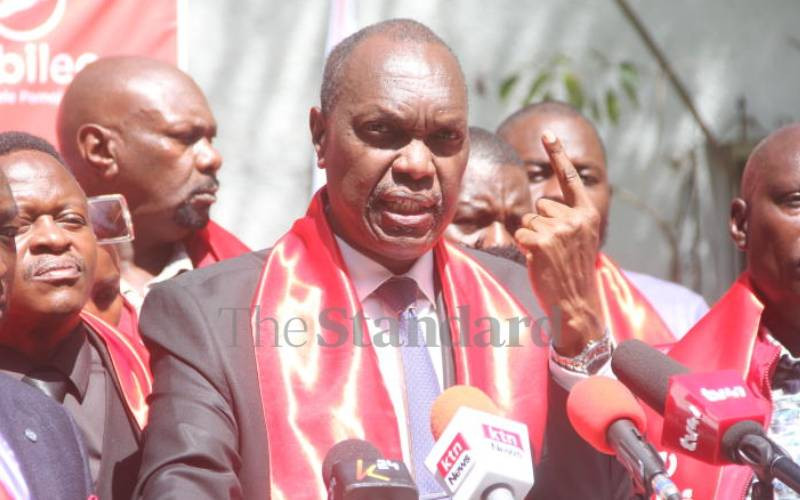By Machua Koinange
Kenya: On February 4, 2013, Mutahi Ngunyi posted his famous tyranny of numbers video on YouTube that quickly went viral. The video infuriated Coalition for Reform and Democracy (CORD) who argued that the elections would not be based on amalgamations of ethnic groups.
Mutahi made one significant observation about his theory. That Jubilee had the numbers to win in round one of the poll and argued that Raila’s efforts “should be geared solely on ensuring that Uhuru did not attain the threshold and by extension force a run off.”
According to TNA Secretary General Onyango Oloo, Mutahi’s numbers confirmed their observations of the situation on the ground but more than that, contradicted polls from the three major firms, Ipsos-Synovate, Infotrak and Strategic Research that the race was headed for a run-off since none of the two leading candidates would attain the 50 per cent plus one required to win the election in the first round of the poll.
Mutahi, who took a lot of heat on social media for his theory, had predicted Uhuru would pick 6.2 million votes mostly from Central and Rift Valley.
He said that the CORD presidential candidate Raila Odinga would garner a minimum 2.8 million votes, a figure which Raila surpassed by 2.5 million in the final tally.
Meanwhile, despite feeling the momentum was in their favour, Jubilee had to deal with opinion polls that had consistently shown Raila was ahead of them four years in a row.
Candidate Uhuru Kenyatta had never led in any of the polls and the perception created was that Raila was the man to beat.
Says Oloo: “We were the underdogs and our opponents were basking in the glory of opinion polls. But the polls were so varied and would often send mixed signals. So we hired an external pollster (from outside the country) with the express instructions not to flatter us.”
The final election outcome had local analysts scratching their heads. The difference was surprising and way outside the margin of error of what most local pollsters had predicted. And there was no run-off.
The mystery of how the polls were at variance with the final official IEBC results confound many to date. Dr Tom Wolf, a research analyst with Ipsos-Synovate, recalled that the results of the company’s last poll based on fieldwork conducted 15-19 February (just over two weeks before the March 4 election) put Uhuru 0.4 per cent ahead of Raila (44.8pc - 44.4pc) with 2 per cent of undecided.
Still, that left a margin of 6 per cent to get over the 50 per cent+1 threshold.” That poll also found that 2 per cent were undecided. “We will never know if those respondents voted,” Wolf noted. But the key factor, as he emphasised at the time Ipsos-Synovate released these results on February 26, 2013, was the ‘turn-out’ factor, which was “impossible to predict”.
But Oloo says Jubilee realised one major mistake local pollsters were making. “Given the intricacies of local politics, we studied the local polls from Rift Valley, for example, and recognised they were not factoring the ethnic formation. Ethnicity was going to be a big factor in the elections,” he said.
Biggest mistake
Their pollster took ethnic make-up into account and gave Jubilee their first report. Oloo says the report confirmed what Jubilee had suspected all along – local pollsters were not only wrong, but that Jubilee would win the elections in the first round by 52 per cent.
Stay informed. Subscribe to our newsletter
“CORD’s biggest mistake was to actually buy into the local polls and believe there would be a run-off,” says Oloo.
Wolf, in an interview with The Standard last year, was surprised to learn that Jubilee hired an external pollster for their own internal analysis. “ I wonder at what point they decided they did not trust local pollsters, and if they did in fact use an external pollster, I would be interested to know the dates they conducted their poll or polls,” he said at that time.
He added: “I would also especially want to know just what their results were – assuming it was a truly random sample, national household-based survey. On what basis would they not trust us, or any other Kenyan firm especially given our quite accurate track-record over several years now?”
He said if a pollster uses a random sample drawn from IEBC voter registration figures, they will be no need to ‘search for’ the right proportion of Catholics, secondary school leavers, people aged between 30-40, those in self-employment or any other variable including ethnicity.
Jubilee insiders have consistently refused to divulge their internal poll results to The Standard, but they contend that the final numbers provided by the external pollster (they would not give the firm’s name) closely mirrored the IEBC results as well as figures from their agents.
Wolf recalled that Ipsos’ January 2013 poll – conducted between the 12th-20th and released at the end of that month – showed Raila ahead at 46 per cent and Uhuru at 40 per cent. “Such a gap may have made Jubilee worried. So if they wanted to do their own poll at that point, of course they had every right to do so,” he said. This was especially so, he added, because their campaign was clearly highly energised, with the Uhuru-Ruto team on an upward-swing in the final weeks.
To illustrate this, Wolf recalls that in July 2012, Ipsos’ poll gave Raila a ten-point margin over Uhuru (33pc-23pc), which dropped to seven in December and six in January 2013 as already noted.
It’s clear, he says, that a higher proportion of the undecided voters – whose figure rose to 22 per cent in December – shifted to Jubilee, especially after the running-mates were officially named.
Still, the question remains as to how UhuRuto got over the 50pc+1 mark. The answer, Wolf says, must remain at least partly incomplete, since a considerable proportion of the evidence presented by CORD in its petition was dismissed by the Supreme Court without being interrogated.
Margin of error
Still, assuming there was no rigging or manipulation, it is not outside the realm of possibility that Uhuru got over the mark, he says. Going by their last poll, Wolf says Uhuru was about 5 per cent shy of 50 per cent but with strong momentum.
Says he: “After Uhuru closed the 6 per cent gap with Raila in the five weeks from January to February, 2013, according to our polls, he had three complimentary strategies for achieving a first round victory: “Poach more supporters of the six minor candidates than Raila, win over most of the undecided voters, and ensure a significantly higher turn-out of voters in Jubilee strongholds than CORD in theirs.”
In retrospect, he says, it appears the latter was the biggest factor. “Our post-election calculations – using IEBC figures – show that Jubilee had a 90 per cent turnout in their strongholds compared to only around an 84 per cent turnout in CORD’s – a 6 per cent spread.”
But these polls, Wolf points out, like all survey research, had their challenges. One was cost, since wanting to reduce the margin of error to a minimum meant using a much bigger sample size than normal, nearly 6,000, compared to the usual 2,000.
Secondly, he says, was the timing of the voter registration process (completed just before Christmas), which meant that they (like other pollsters) did not know the actual population-distribution of potential voters until the end of the year. Before that, the only other option was relying on the updated 2009 census figures.
Finally, with the other 95 per cent of selected respondents claiming to be registered voters, when actually only about two-thirds of adult Kenyans were (14.3 million out of about 22 million adults), Wolf believes some of those interviewed must have lied about their registration status.
He, however, says there is no reason to believe that there were more such ‘liars’ on one side of the political divide than the other.
Altogether, even if there had not been a highly contentious Supreme Court case and decision, the gap between the final polls and the official result is certain to generate controversy for some time to come.
And the same applies to the joint University of California, San Diego and Harvard University exit poll, which also showed neither candidate within 8 per cent of the magic 50pc+1 mark. About 12 per cent of those interviewed had however declined to reveal whom they voted for.
Nevertheless, Wolf says it would still be quite interesting what results the Jubilee-hired survey firm came up with, though the dates of the survey and the sampling methodology used would also be vital to know.
The presidential debates were expected to help shift the poll numbers as election day drew closer. But political analysts had forecasted that those who watched the debates had already made up their minds.
The debates were of interest mostly to undecided voters who accounted for 2 per cent of registered voters, according to local pollsters.
 The Standard Group Plc is a
multi-media organization with investments in media platforms spanning newspaper
print operations, television, radio broadcasting, digital and online services. The
Standard Group is recognized as a leading multi-media house in Kenya with a key
influence in matters of national and international interest.
The Standard Group Plc is a
multi-media organization with investments in media platforms spanning newspaper
print operations, television, radio broadcasting, digital and online services. The
Standard Group is recognized as a leading multi-media house in Kenya with a key
influence in matters of national and international interest.
 The Standard Group Plc is a
multi-media organization with investments in media platforms spanning newspaper
print operations, television, radio broadcasting, digital and online services. The
Standard Group is recognized as a leading multi-media house in Kenya with a key
influence in matters of national and international interest.
The Standard Group Plc is a
multi-media organization with investments in media platforms spanning newspaper
print operations, television, radio broadcasting, digital and online services. The
Standard Group is recognized as a leading multi-media house in Kenya with a key
influence in matters of national and international interest.









